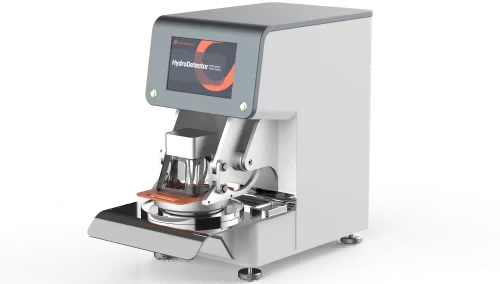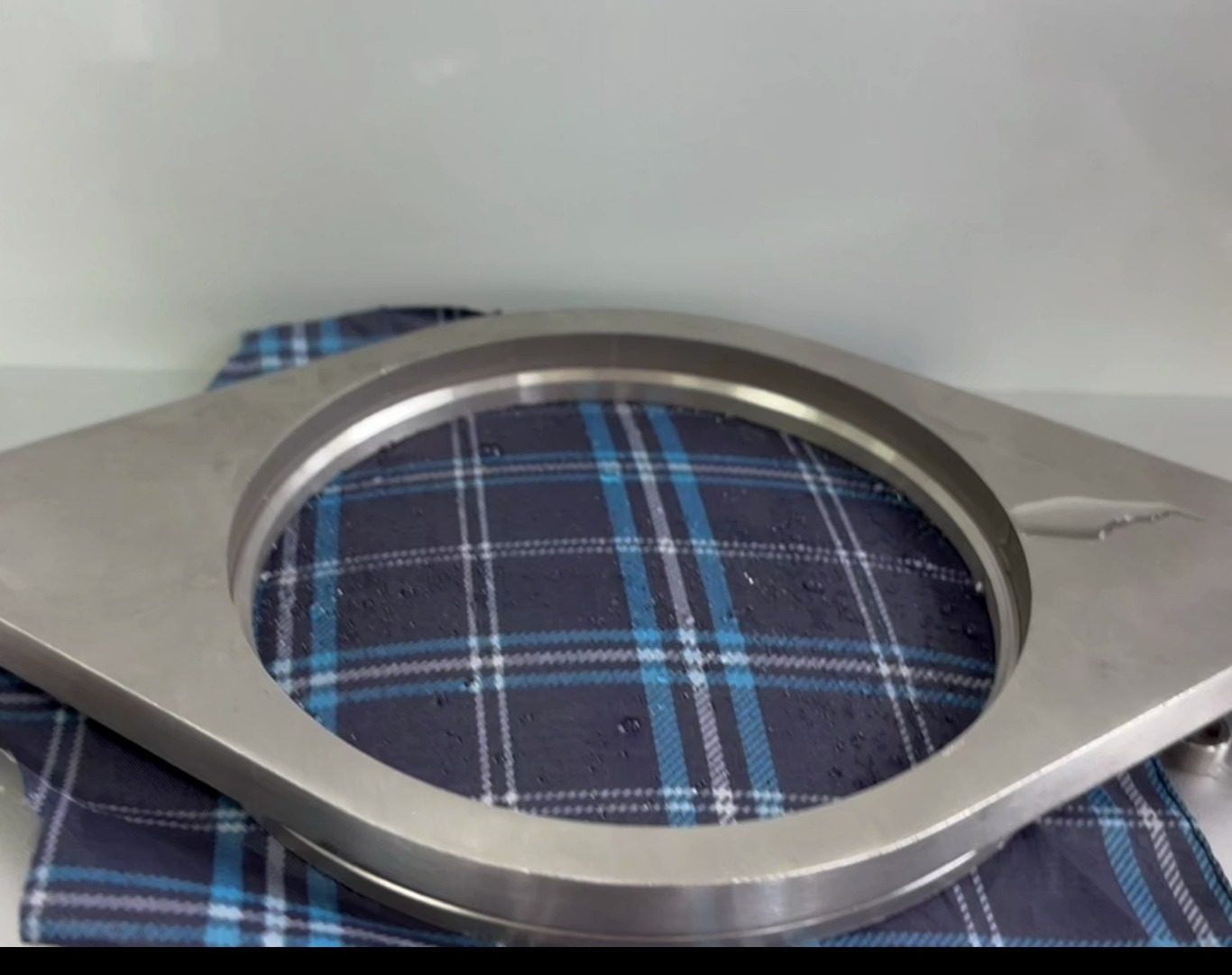Hydrostatic pressure resistance is a key measure of waterproof, breathable fabrics. It refers to the resistance when water passes through the fabric. It indicates how much the fabric resists water penetration. The hydrostatic pressure resistance method measures two things. It tests the fabric’s waterproofness and its nature.
Fabrics’ water repellency can be measured by three indexes: water staining, hydrostatic pressure, and water penetration. The hydrostatic pressure resistance level is water permeability. The water staining level is its rejection of water. The higher the hydrostatic pressure a fabric can withstand, the better its water repellency.
Testing Principle
The hydrostatic pressure test is a common way to assess fabric impermeability. It measures the resistance of the fabric to water. Under standard conditions, rising water pressure is applied to one side of the specimen. This continues until three seepage points appear on the other side. The team records the water pressure at the time of the third seepage point. The specimen’s waterproof performance is then evaluated.
FZ/T01004-2008 Determination of water permeability of coated fabrics
ISO811-1981 Determination of water permeability of textiles hydrostatic pressure test
ISO1420-2016 Determination of water permeability of rubber or plastic coated textiles
ISO9073-16-2007E Test methods for textile nonwovens Part 16. Resistance to water penetration (hydrostatic pressure).
AATCC127-2014 Determination of water penetration resistance hydrostatic pressure test
JISL1092:2009 Test Method for Water Repellency of Textiles
Comparison of test methods
1 Classification according to the method of testing
(1) Field test. The field test is costly and time-consuming, usually taking about half a year. The textile’s waterproofness is regularly tested during the test period. This is to check the durability of the waterproof and moisture-permeable finish. Although this method is long and costly, the data obtained from the test is accurate.
② Simulation test. Simulation testing must have an environmentally controlled room. The room has an artificial rain tower. It pumps 450L/(m²-h) of water from 10m high, simulating a torrential downpour on a mannequin. The 2,000 holes at the top release 5mm droplets at about 40km/h, reaching a maximum of 90% humidity in the air. By adjusting this, we can imitate showers of varying intensity over an area of about 2m. The mannequin’s surface has sensors. They check the time and place of the last water transmission, among other things. This testing method is much shorter than field testing. A team can complete it in a few days, but it is more expensive.
③Laboratory testing. Lab tests are better than field and simulation tests. They are cheaper, faster, and provide useful results. There are two types of tests for the waterproofness of fabrics. This is after finishing them to be waterproof and moisture-permeable. The first category is hydrostatic pressure test. The second category is the spray test. It tests a fabric’s ability to resist water sprayed at a certain height and angle. It measures how long it takes for water to soak through the fabric. After a time, it measures the amount of water absorbed by the fabric. It also observes any water damage. This follows the principle of ISO4920, a rainproof performance test.
2 according to the form of pressure classification
① dynamic method. To test the fabric’s water pressure, measure the pressure until a set number of droplets appear on the other side. This will show the maximum hydrostatic pressure the fabric can withstand.
② static method. Test the fabric on one side to a certain water pressure. Then, measure how long it takes for water to penetrate to the other side.
3 Can withstand hydrostatic pressure according to the size of the value of classification
① low-pressure test method.
Standard test methods are:
China’s national standard GB/T4744-1997, ‘textile water permeability determination of hydrostatic pressure test’
China’s FZ/T01004-1991 standard tests coated fabrics for water permeability using hydrostatic pressure.
The Canadian standard (CGSB) -4.2 No. 26.3 a 1995, ‘textile fabric impermeability determination of hydrostatic pressure test,’ uses a low-pressure method.
ISO 1420:1987, ‘rubber and plastic coated fabrics – test for impermeability to hydrostatic pressure’
Japanese Industrial Standard JIS L 1092, ‘textile water resistance hydrostatic pressure test A’
AATCC 127, ‘textile water resistance hydrostatic pressure test’
ASTM D 751 (1995), ‘coated fabrics water resistance determination B’
High-pressure test methods. Standard test methods are: FZ/T01004-1991, ‘coated fabric water permeability, hydrostatic pressure test (high-pressure method)’; ISO 1420:1987, ‘rubber and plastic coated fabric water permeability, hydrostatic pressure test’; JIS L 1092, ‘textile water resistance, hydrostatic pressure test B’; ASTM D 751 (1995), ‘coated fabrics, water resistance test’; and FED-STD-191A, 5512.
Test Procedure
1 Humidification and test atmosphere
The parties agree on the moisture conditioning and test atmospheres. You can conduct the tests at room temperature or in the ambient conditions.
2 Sample Preparation
After sampling, minimise handling of the specimen and avoid forceful folding. In addition to humidification without any treatment (such as ironing). Cut at least 5 specimens from different parts of the fabric. The specimen size must meet the test area’s requirements. The specimens should be as representative as possible. The team may not cut the specimens for testing. Do not carry out tests on areas with deep folds or creases. If we must find the hydrostatic pressure at the joints, make them in the middle of the specimen.
3 Starting the test
Use clean distilled or deionised water for each specimen.
Wipe the test water from the clamping device (Hydrostatic Pressure Tester). Then, hold the wetted specimen so its front side contacts the water. When clamping the specimen, ensure the test water does not pass through it under pressure before the test starts.
(Note: If the fabric’s front side is unknown, one side of the single-coated fabric must contact the water. Test the other two sides separately and report those results.)
Apply a continuously increasing water pressure to the specimen. Raise the pressure at a rate of 6.0 kPa/min ± 0.3 kPa/min (60 cm H₂O/min ± 3 cm H₂O/min). Then, observe the water seepage.
(Note: If you choose another rate of water pressure rise, e.g., 1.0 kPa/min, indicate this in the report.))
Record the value of hydrostatic pressure at the time when the third water droplet on the specimen first appears. Disregard those fine water droplets that form and then do not increase in size. Continuous water droplets that seep out at the same place on the fabric are not cumulative. If the third droplet appears at the edge of the clamp, its pressure must be lower than the lowest of the other specimens. If so, we will exclude the data. We will test additional specimens until we get normal results.
(Note: If the test shows a break in the fabric water column, or if the composite fabric bulges, record the pressure. Then, explain the test results in the report.)
Analysis of test results
State the hydrostatic pressure of each specimen and its average P in kPa (cmH₂O). Use one decimal place. For the same sample, use different specimen types (e.g., seamed and unseamed). Calculate their average hydrostatic pressure values separately.
We test the waterproof performance of different specimens of the same sample, separately.
Recently, the Entry-Exit Inspection and Quarantine Bureau raised the water pressure resistance test for textiles. It is now much higher than in the past. European customers have higher standards for textiles’ hydrostatic resistance. The minimum is above 5.88kPa. Some even require over 9.8kPa. The sampling test results show that, with a 5.88kPa standard, 44% of the samples fail. With a 9.8kPa standard, 69% fail. This directly affects exports.
Common problems in hydrostatic pressure testing
Problems caused by improper operation in the hydrostatic pressure testing process
Before clamping the specimen, ensure there is no air between it and the water. Then, clamp the specimen for the test. If air exists between the test specimen and the water, the water cannot fully contact the specified area. Some of the specimen will not have water droplets. This will affect the experiment’s results.
During the test, try to ensure that the edge of the specimen clamping device does not seep or leak. If the specimen seeps or leaks at the clamping device’s edge, water will leak out during the test. This will cause the test pressure of the specimen to rise erratically. It will affect the accuracy of the results.
Problems arising from the determination of the test endpoint
The test standard for hydrostatic pressure, ‘Test and Evaluation of Waterproof Performance of Textiles Hydrostatic Pressure Method,’ states to record the hydrostatic pressure when the third water droplet appears on the specimen. The test ends at that point. If someone selects the wrong test endpoint, it will affect the results of the experiment. This will lead to incorrect conclusions.
Some special cases are as follows:
If the third droplet appears at the edge of the clamp, check its hydrostatic pressure. If it’s lower than the lowest value of other normal specimens, reject the data. Test more specimens until you obtain normal results. The clamping device can damage the specimen’s edge. There may be water seepage at the edges. We must test and analyze the results. We need to check if the test value is lower than the lowest value of other normal specimens. If it is, we need to add more specimens.
In the standard notes, the experiment’s provisions are to: 1. If the fabric ruptures, or if the water column spray or composite fabrics bulge, record the pressure at that time. 2. Explain the phenomena in the report. The occurrence of the above conditions should be the end point of the test of the experiment.
Handling problems of abnormal situations
① If the hydrostatic pressure test results of a large coefficient of dispersion, if the average test results qualified, individual test single value failed, it is recommended that the judgement is consistent with the report to indicate the individual unqualified test single value.
If the specimen wets when it contacts the water before the test, the result is 0. The report will note that contact with the water wets the specimen.
For more information on textile testing methods/standards
or textile testing machines, contact us:
What’s App: +86 180 2511 4082
Tel: +86 769 2329 4842
Fax: +86 769 2329 4860
Email: sales@chiuvention.com



